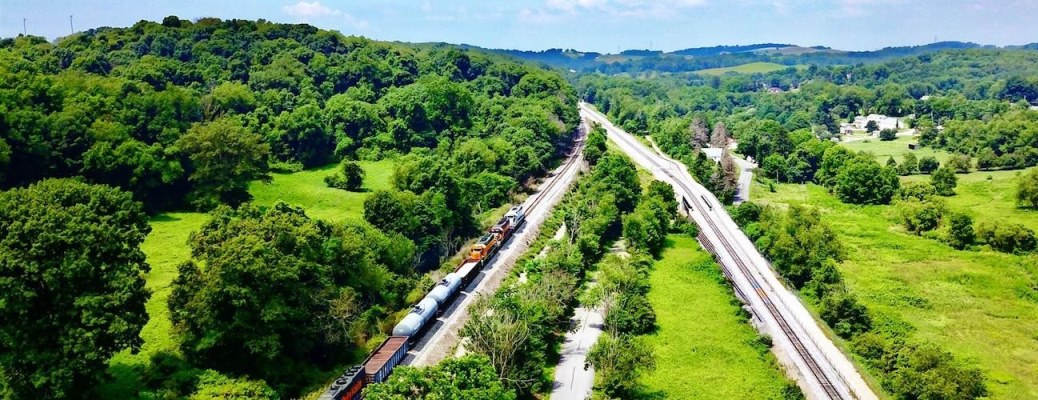On March 18, 2020, the Rails-to-Trails Conservancy (RTC) and its regional partners, released findings and recommendations from a study outlining the path forward in connecting Cleveland, Ohio and Pittsburgh, Pennsylvania by trail.
The feasibility study serves as a blueprint to complete the Cleveland to Pittsburgh Corridor (C2P). This is one of the mega-corridors of the Industrial Heartland Trails Coalition’s (IHTC) vision for a 1500-miles-plus trail network that connects Pennsylvania, West Virginia, Ohio and New York, and a segment of the even larger Great American Rail-Trail, a 3,700-miles-plus cross-country route.
“The C2P has the potential to be an anchor for economic opportunity and driver of quality of life for the Industrial Heartland,” said Eric Oberg, director of trail development for RTC’s Midwest Regional Office.
“We’ve seen time and again that trails are smart economic development strategies—RTC’s research consistently finds that trail communities can benefit from as much as $7 million in direct trail user spending, not to mention the jobs, tourism dollars and small businesses that emerge as part of a trail economy. This study details how the towns between Pittsburgh and Cleveland can unlock that potential,” he added.
The study found that completing the 72 miles of trail gaps that exist in the C2P trail corridor creates opportunities to unlock the region’s potential—in terms of economic growth, rural resilience, quality of life and historic preservation.
As RTC’s research finds, trails increasingly demonstrate their significance in community transformation by generating economic activity from trail users, including visitors and locals. RTC’s studies further demonstrate the power of connecting trails in terms of direct economic potential and trail usage. As trail gaps are closed, trail use increases by as much as 80% depending on the significance of the gap closure.
The benefits of connectivity have ripple effects across the entire trail network, delivering increased trail use of as much as 15% in other sections of the network.
Representatives of the National Park Service, state and local officials; transportation, trail and economic development experts; business leaders; and other critical stakeholders joined RTC at a virtual event that unveiled the blueprint for and economic potential of connecting Cleveland to Pittsburgh by trail.
RTC’s call for support and investment to complete the gaps in the corridor is bolstered by the Ohio Department of Natural Resources state trails plan, the Ohio Trails Vision, which includes Ohio’s parts of the IHTC’s 1,500-miles-plus regional trail network vision and the Great American Rail-Trail. The state trails plan guides policy and investment surrounding the development of the state’s trail system.
The feasibility study offers:
- An assessment of the current conditions and feasibility of C2P trail development;
- An opinion of probable costs for acquisition and construction of each trail gap;
- Recommendations and an action plan for completing the C2P trail corridor; and
- A comprehensive vision for connecting the C2P Corridor in Pennsylvania, Ohio and West Virginia, providing tools and resources for planners and partners who are working to build trails, improve community connections, and encourage the use and stewardship of existing trails.
Once connected, the C2P trail corridor will feed into the Industrial Heartland Trails Coalition’s (IHTC) regional vision to leverage a burgeoning trail economy to deliver new opportunities to the people who live along the 1,500-miles-plus network, which stretches across 51 counties in New York, Pennsylvania, Ohio and West Virginia.
“As the nation grapples with uncertainty surrounding the COVID-19 situation, studies like this one offer us a guide for how we might develop important public assets that can assist in aspects of recovery. Trails are powerful stimulators of economic development, especially in more rural regions. The opportunity to leverage a connected trail system to create a vibrant active tourism and outdoor economy for the region has never been more prescient,” concluded Oberg.
The C2P corridor also contributes 146 miles to the Great American Rail-Trail, a signature RTC project and the nation’s first cross-country multi-use trail, creating a 3,700-miles-plus route that will be ultimately separated from vehicle traffic and entirely walkable and bikeable between Washington, DC and Washington State.
Photo of the Montour Trail in Pennsylvania is courtesy of RTC/ Milo Bateman.

